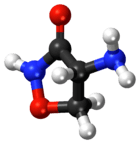Cycloserine
 | |
 | |
| Clinical data | |
|---|---|
| Trade names | Seromycin |
| AHFS/Drugs.com | Monograph |
| License data | |
| Pregnancy category |
|
| ATC code | J04AB01 (WHO) |
| Legal status | |
| Legal status |
|
| Pharmacokinetic data | |
| Bioavailability | ~70% to 90% |
| Metabolism | Hepatic |
| Biological half-life | 10 hrs (normal renal function) |
| Excretion | Renal |
| Identifiers | |
| |
| CAS Number |
68-41-7 |
| PubChem (CID) | 6234 |
| DrugBank |
DB00260 |
| ChemSpider |
5998 |
| UNII |
95IK5KI84Z |
| KEGG |
D00877 |
| ChEBI |
CHEBI:40009 |
| ChEMBL |
CHEMBL771 |
| NIAID ChemDB | 007654 |
| ECHA InfoCard | 100.000.626 |
| Chemical and physical data | |
| Formula | C3H6N2O2 |
| Molar mass | 102.092 g/mol |
| 3D model (Jmol) | Interactive image |
| |
| |
| (verify) | |
Cycloserine (4-amino-3-isoxazolidinone) is an amino acid derivative with an unusual structure. It is a colorless solid that is produced by some bacteria. It has emerged as a drug sold under the brand name Seromycin. It is an antibiotic effective against Mycobacterium tuberculosis.
It is on the World Health Organization's List of Essential Medicines, the most important medications needed in a basic health system.[1]
Medical uses
Tuberculosis
For the treatment of tuberculosis, cycloserine is classified as a second-line drug, i.e. its use is only considered if one or more first-line drugs cannot be used. Hence, cycloserine is restricted for use only against multiple drug-resistant and extensively drug-resistant strains of M. tuberculosis. Another reason for limited use of this drug is the neurological side effects it causes, since it is able to penetrate into the central nervous system (CNS) and cause headaches, drowsiness, depression, dizziness, vertigo, confusion, paresthesias, dysarthria, hyperirritability, psychosis, convulsions, and shaking (tremors).[2][3] Overdose of cycloserine may result in paresis, seizures, and coma, while alcohol consumption may increase the risk of seizures.[3] Coadministration of pyridoxine can reduce the incidence of some of these CNS side effects (e.g. convulsions) caused by cycloserine.
Psychiatry
A 2015 Cochrane review found no evidence of benefit in anxiety disorders as of 2015.[4] Another review found preliminary evidence of benefit.[5] Evidence for use in addiction is tentative but also unclear.[6]
Mechanism of action
Cycloserine works as an antibiotic by inhibiting cell-wall biosynthesis in bacteria.[7][8] As a cyclic analogue of D-alanine, cycloserine acts against two crucial enzymes important in the cytosolic stages of peptidoglycan synthesis: alanine racemase (Alr) and D-alanine:D-alanine ligase (Ddl).[8] The first enzyme is a pyridoxal 5'-phosphate-dependent enzyme which converts the L-alanine to the D-alanine form.[8] The second enzyme is involved in joining two of these D-alanine residues together by catalyzing the formation of the ATP-dependent D-alanine-D-alanine dipeptide bond between the resulting D-alanine molecules.[8] If both of these enzymes are inhibited, then D-alanine residues cannot form and previously formed D-alanine molecules cannot be joined together.[8] This effectively leads to inhibition of peptidoglycan synthesis.[8]
Chemical properties
Under mildly acidic conditions, cycloserine hydrolyzes to give hydroxylamine and D-serine.[9][10] Cycloserine can be thought of a cyclized version of serine, with an oxidative loss of dihydrogen to form the nitrogen-oxygen bond.
Cycloserine is stable under basic conditions, with the greatest stability at pH = 11.5.[9]
History
The compound was first isolated nearly simultaneously by two teams. Workers at Merck isolated the compound, which they called oxamycin, from a species of Streptomyces.[11] The same team prepared the molecule synthetically.[12] Workers at Eli Lilly isolated the compound from strains of Streptomyces orchidaceus. It was shown to hydrolyze to serine and hydroxylamine.[13]
Economics
In the U.S., the price of cycloserine increased from $500 for 30 pills to $10,800 in 2015 after the Chao Center for Industrial Pharmacy and Contract Manufacturing changed ownership to Rodelis Therapeutics in August 2015.[14] The price increase was rescinded after the previous owner, the Purdue University Research Foundation, which retained "oversight of the manufacturing operation" intervened and Rodelis returned the drug to an NGO of Purdue University. The foundation now will charge $1,050 for 30 capsules, twice what it charged before". Eli Lilly has been criticised for not having kept more control over pricing and ensuring that the philanthropic initiative continued to be met. According to a Lilly spokesperson, the company had no way to control the price of the drug after it was outlicensed due to antitrust laws.[15]
Research
There is some experimental evidence to suggest that D-cycloserine aids in learning by helping form stronger neural connections.[16] It has been investigated as an aid to facilitate exposure therapy in people with PTSD and anxiety disorders[17][18] as well as schizophrenia.[19]
References
- ↑ "19th WHO Model List of Essential Medicines (April 2015)" (PDF). WHO. April 2015. Retrieved May 10, 2015.
- ↑ Nitsche, Michael; Jaussi, W.; Liebetanz, D.; Lang, N.; Tergau, F.; Paulus, W. (2004). "Consolidation of human motor cortical neuroplasticity by D-cycloserine". Neuropsychopharmacology. 29 (8): 1573–1578. doi:10.1038/sj.npp.1300517. PMID 15199378.
- 1 2 "CYCLOSERINE: Human Health Effects". National Institutes of Health.
- ↑ Ori, R; Amos, T; Bergman, H; Soares-Weiser, K; Ipser, JC; Stein, DJ (10 May 2015). "Augmentation of cognitive and behavioural therapies (CBT) with d-cycloserine for anxiety and related disorders.". The Cochrane database of systematic reviews. 5: CD007803. doi:10.1002/14651858.CD007803.pub2. PMID 25957940.
- ↑ Schade, S; Paulus, W (12 September 2015). "D-Cycloserine in Neuropsychiatric Diseases: A Systematic Review.". The International Journal of Neuropsychopharmacology: pyv102. doi:10.1093/ijnp/pyv102. PMID 26364274.
- ↑ Myers, KM; Carlezon WA, Jr (1 June 2012). "D-cycloserine effects on extinction of conditioned responses to drug-related cues.". Biological Psychiatry. 71 (11): 947–55. doi:10.1016/j.biopsych.2012.02.030. PMID 22579305.
- ↑ Lambert, M. P. (1972). "Mechanism of D-cycloserine action: Alanine racemase from Escherichia coli W". Journal of Bacteriology. 110 (3): 978–987. PMC 247518
 . PMID 4555420.
. PMID 4555420. - 1 2 3 4 5 6 Prosser, Gareth; de Carvalho, Luiz Pedro S. (February 2013). "Kinetic mechanism and inhibition of Mycobacterium tuberculosis d-alanine: D-alanine ligase by the antibiotic d-cycloserine". FEBS Journal. 280 (4): 1150–1166. doi:10.1111/febs.12108. PMID 23286234.
- 1 2 Kaushal, Gagan; Ronaldo Ramirez; Demelash Alambo; Wacharah Taupradist; Krunal Choksi; Cristian Sirbu (October 2011). "Initial characterization of D-cycloserine for future formulation development for anxiety disorders". Drug Discoveries & Therapeutics. 5 (5): 253–260. doi:10.5582/ddt.2011.v5.5.253. PMID 22466372.
- ↑ Silverman, Richard (1998). "An Aromatization Mechanism of Inactivation of γ-Aminobutyric Acid Aminotransferase for the Antibiotic l-Cycloserine". Journal of the American Chemical Society. 120 (10): 2256–2267. doi:10.1021/ja972907b.
- ↑ Kuehl, Frederick A.; Jr; Wolf, Frank J.; Trenner, Nelson R.; Peck, Robert L.; Buhs, Rudolf P.; Putter, Irvin; Ormond, Robert; Lyons, John E.; Chaiet, Louis; Howe, Eugene; Hunnewell, Berl D.; Downing, Geo; Newstead, E.; Folkers, Karl (1955). "D-4-Amino-3-isoxazolidinone, a new antibiotic". Journal of the American Chemical Society. 77: 2344–5. doi:10.1021/ja01613a105.
- ↑ Stammer, Charles H.; Wilson, Andrew N.; Holly, Frederick W.; Folkers, Karl (1955). "Synthesis of D-4-amino-3-isoxazolidinone". Journal of the American Chemical Society. 77: 2346–7. doi:10.1021/ja01613a107.
- ↑ Hidy, Phil H.; Hodge, E. B.; Young, Vernon V.; Harned, Roger L.; Brewer, Glenn A.; Phillips, W. F.; Runge, W. F.; Stavely, Homer E.; Pohland, A.; Boaz, H.; Sullivan, H. R. (1955). "Structure and reactions of cycloserine". Journal of the American Chemical Society. 77: 2345–6. doi:10.1021/ja01613a106.
- ↑ ANDREW POLLACK (20 September 2015). "Drug Goes From $13.50 a Tablet to $750, Overnight". Retrieved 21 September 2015.
- ↑ ANDREW POLLACK (21 September 2015). "Big Price Increase for Tuberculosis Drug Is Rescinded". NYT. Retrieved 24 September 2015.
- ↑ "Learning and Brain Activity Are Boosted by a Dose of a Small-Molecule Compound". Scientific American.
- ↑ Bowers ME, Ressler KJ. An Overview of Translationally Informed Treatments for Posttraumatic Stress Disorder: Animal Models of Pavlovian Fear Conditioning to Human Clinical Trials. Biol Psychiatry. 2015 Sep 1;78(5):E15-27. PMID 26238379
- ↑ Singewald N et al. Pharmacology of cognitive enhancers for exposure-based therapy of fear, anxiety and trauma-related disorders. Pharmacol Ther. 2015 May;149:150-90. PMID 25550231 free full text
- ↑ Goff DC.D-cycloserine: an evolving role in learning and neuroplasticity in schizophrenia. Schizophr Bull. 2012 Sep;38(5):936-41. PMID 22368237 free full text